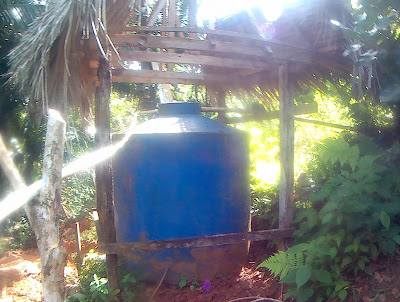 |
| Waiting to sell cacao beans |
These folks are waiting in line (or on line) to sell
their cacao beans to the Coop. Waiting in line is something folks around here
do quite well.
These farmers have gone into the jungle and cleared some land (and possibly filed a land claim). Then they planted the cacao seeds of choice and waited 5 years. After that, they will get two harvests per year, where they pick the fruit, cut it open, clean the seeds (beans) and set them out to dry. Then they will shell the outer husk, bag them and haul them out of the jungle.
These farmers have gone into the jungle and cleared some land (and possibly filed a land claim). Then they planted the cacao seeds of choice and waited 5 years. After that, they will get two harvests per year, where they pick the fruit, cut it open, clean the seeds (beans) and set them out to dry. Then they will shell the outer husk, bag them and haul them out of the jungle.
 |
| Drying cacao beans |
When it's time to sell, they have two options : Sell to the local "agent" for about $0.90/lb cash. These agents are in most of the smaller villages that have road access - relatively convenient. Or they can wait until one of the Coop depots are open - one day a week. These are only in Almirante and Changuinola. But the price is about $1.30/lb - almost 50% MORE !! Then again, the Coop only pays by check so the sellers must go to the bank and wait again.
Either way, the cacao that is the basis for all your
chocolate delights has a well-earned beginning.
 |
| Selling Christmas trees in the tropics |
Christmas always feels a little odd in the tropics. Yet even here in Changuinola, Panama, cut trees are available - shipped in from Canada. Price tags were from $45 to $85, but include the stand.
No
official Thanksgiving here in Panama. Only a token Día de Acción de Gracias.
But, that doesn't stop me from being thankful for the rich, diverse and unique
life I've lived (and continue to live).
The promised turkey at my favorite restaurant turned out to be sliced turkey loaf, so I opted for ham and lobster instead. No pumpkin pie, but the banana bread was pretty good.
The promised turkey at my favorite restaurant turned out to be sliced turkey loaf, so I opted for ham and lobster instead. No pumpkin pie, but the banana bread was pretty good.
Goyo's Better Homes & Gardens Tour of Barriada
Guerra.
I visited to check on a PCVs water project completed last year.
Everything is running (near) perfectly, so I toured the 'hood and chatted with
folks. They were pretty excited that they got electricity two months ago.
11 Site visits down
and 5 to go
!!
Particularly fond of the little pig house !!
Today
begins the week-long binge of dances, parades and boozing that is Fiestas
Patrias, a celebration of the Declaration of Independence from Spain. Imagine
Thanksgiving that lasts 10 days.
Fortunately for me, the party is mostly in the cities, so I'll still be able to get some work done out in the campo.
I tried doing the big party thing once (Mardi Gras in Panama City ) which made me highly irregular and I swore I'd never do it again.
Fortunately for me, the party is mostly in the cities, so I'll still be able to get some work done out in the campo.
I tried doing the big party thing once (Mardi Gras in Panama City ) which made me highly irregular and I swore I'd never do it again.
























